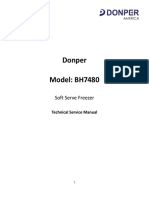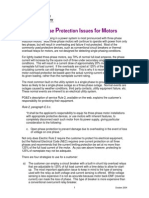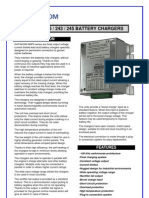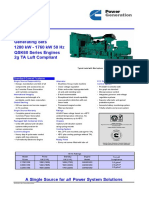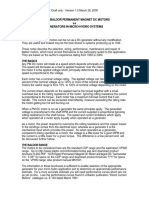Braking Resistors
Braking Resistors
Uploaded by
caspermalCopyright:
Available Formats
Braking Resistors
Braking Resistors
Uploaded by
caspermalCopyright
Available Formats
Share this document
Did you find this document useful?
Is this content inappropriate?
Copyright:
Available Formats
Braking Resistors
Braking Resistors
Uploaded by
caspermalCopyright:
Available Formats
Braking Resistors for VFDs
Application: Ac variable frequency drives are commonly used with a general purpose AC induction motor to form a reliable variable speed drive system. For applications that require faster deceleration rates, or where motor speeds are exceeding the synchronous speed set up by the output frequency of the drive (an overhauling load condition), a braking resistor is required. Braking resistors increase the braking torque capability of a variable frequency drive, producing faster and more controlled braking. The resistor dissipates regenerated power to keep the bus voltage from exceeding the rated limit of the drive. The duty cycle determine the power rating of the braking resistor. Duty cycle is calculated by dividing the breaking stop time by the total cycle time as follows: Duty Cycle - tb / tc x 100% Also, it is important to determine whether your application is an overhauling load cycle or a deceleration braking cycle. Overhauling Load Cycle: Requires the braking resistor to keep the motor from increasing speed beyond the synchronous speed set up by the drive. During overhauling load cycle, the required braking torque remains constant; therefore, approximately twice the power of an deceleration braking cycle is required of the braking resistor. Deceleration Braking Cycle: Requires the braking resistor to stop or reduce the speed of the motor. During deceleration braking, the required braking torque reduces with speed, therefore, approximately one-half the power of an overhauling load cycle is required of the braking resistor. Caution: It is very important to insure that the resistance listed in chart below is greater than the minimum specified for your drive or braking module. Installing a braking resistor with too low of a resistance value will cause permanent damage to your drive or braking module. Please call the factory if you need assistance. Construction: Dynamic braking Resistors are constructed from continuously wound with Nickel Chromium on asbestos tube or steel plate depends on current/ohm rating. Depends on wattage rating number of tubes vary. Normally each tube will have wattage rating around 1000-2500W. Without enclosure all tubes are fixed in end plate and supplied in open condition. This assembly will be fixed inside VFD panel and necessary cooling arrangements should be provided in the panel to remove heat generated during braking. Wiring connections are made directly to
How Dynamic Braking Resistor Work: The drive manufacturer normally determines the power rating (watts) needed to prevent overheating during braking duty. The peak braking current is determined by the specified resistance value. Each drive manufacture specifies a resistance range with a minimum to prevent over current and damages to the drive and a maximum value to give adequate lower dissipation capability. During braking, the VFD ramps the frequency to zero. The rotational energy of the motor and load are driven back through the inverter to the DC bus and the rotational energy is dissipated through the resistor. Braking Torque: The resistance determines the braking torque and thus the deceleration rate of the motor. It is important that the resistance value must be within the allowable limits of the drive or baking module (too low of a value may cause harm to the drive or chopper). Also when the braking module activates, the resistance value will produce a specific braking current. The peak braking currents of each standard design are listed with each resistor design and must not exceed the rate limits of your drive or banking module. Duty Cycle:
resistor terminals. The wire should be high temperature grade since the resistor element may go up to 350 degrees during braking. Temperature Rise Limits: Unless, otherwise specifically confirmed by us, all the resistors are designed for Temperature Rise up to 375 deg. C. over ambient temperature, except Dynamic Breaking Resistors. Further resistors can also be designed as per customers requirement & specifications for different temperature Rise limits and for that matter any limit can be achieved. Dynamic Breaking Resistors are designed for maximum Temperature Rise of 760 deg. C as per IEEE 32 Braking Resistor Installation: Braking Resistors are available in open construction and with enclosure. Open Resistors are designed for mounting within appropriate electrical equipment enclosure. Resistor rated 5KW and under are recommended for mounting inside switch gear cubicle. The DBR should be mounted in the upper part of the cubicle to avoid over heating the installed switch gears. Allow side clearances of 100mm and vertical clearances of 150mm for proper heat dissipation and access.
The part of the enclosure containing Braking resistors must be forced ventilated according the dissipated power. Minimum Air flow must be: F= 0.04 X Ps in (Ps = power dissipated by the Braking Resistor) Limited Warranty: GR Electronics warrants to the original purchaser only that the reactors will be free from defects in material and workmanship for period of one year from the date of shipment. Our liability is limited only to the repair or replacement of product defective in materials or workmanships. GR shall not in any event, be liable for incidental damages or consequential damage or economic loss. This warranty shall not apply to the defects that occur to improper storage, handling or misuse. Tests conducted at our works Visual inspection for general workmanship, Quality and finish. Measurement Resistance Value Measurement of Insulation resistance with Insulation tester. High Voltage test at 2KV for one minute between live parts to earth
Braking Resistor for 100% Torque Drive Ohm Brak. Brake resistor watts Kw/Hp Amps 30%duty 50%duty 0.75/1.0 750 1.1 0.225 0.375 1.5/2.0 375 2.1 0.45 0.75 2.2/3.0 250 3.2 0.675 1.12 3.7/5.0 150 5.3 1.125 1.87 5.5/7.5 100 8.0 1.70 2.80 7.5/10 75 11.0 2.25 3.75 11/15 50 16 3.40 5.60 15/20 38 21 4.50 7.50 18.5/25 30 27 5.60 9.40 22/30 25 32 6.75 11.25 30/40 19 42 9.00 15.00 37/50 15 53 11.25 18.75 45/60 12.6 63 13.50 22.50 56/75 10.0 80 16.80 28.00 75/100 7.5 110 22.50 37.50 95/125 6.0 130 28.10 46.90 112/150 5.0 160 33.70 56.00 150/200 3.8 210 45.00 75.00 187/250 3.0 270 56.00 94.00 220/300 2.5 320 67.50 112.00
Braking Resistor for 150% Torque Drive Ohm Brak. Brake resistor watts Kw/Hp Amps 30%duty 50%duty 0.75/1.0 500 1.6 0.335 0.560 1.5/2.0 250 3.2 0.67 1.12 2.2/3.0 170 4.7 1.00 1.70 3.7/5.0 100 8.0 1.70 2.80 5.5/7.5 67 12 2.50 4.20 7.5/10 50 16 3.35 5.60 11/15 34 24 5.00 8.40 15/20 25 32 6.70 11.20 18.5/25 20 40 8.40 14.00 22/30 17 47 10.00 16.80 30/40 12.6 63 13.40 22.40 37/50 10.0 80 16.75 28.00 45/60 8.4 95 20.00 33.60 56/75 6.7 120 25.00 42.00 75/100 5.0 160 33.50 56.00 95/125 4.0 200 42.00 70.00 112/150 3.4 235 50.00 84.00 150/200 2.5 320 67.00 112.0 187/250 2.0 400 84.00 140.0 220/300 1.7 470 100.00 168.0
You might also like
- BJ8504 ShortCircuits 2 310316 PDFDocument148 pagesBJ8504 ShortCircuits 2 310316 PDFJosh Christensen100% (1)
- Variable Frequency Drive (VFD) Interview QuestionsDocument9 pagesVariable Frequency Drive (VFD) Interview QuestionsMohammad Badii Mosli100% (1)
- Technical Data ManualDocument213 pagesTechnical Data ManualKanth KanthanNo ratings yet
- John Deere Diesel GensetDocument2 pagesJohn Deere Diesel Gensetnanocycle0% (1)
- Electric Motor TestingDocument5 pagesElectric Motor Testings_r_manoNo ratings yet
- Donper Technical SheetDocument35 pagesDonper Technical SheetDeniz Wu67% (3)
- AF-650 GP General Purpose Drive: Brake Resistor Design GuideDocument30 pagesAF-650 GP General Purpose Drive: Brake Resistor Design GuideonafetsNo ratings yet
- Pen-Hase Rotection Ssues or Otors: Pacific Gas and Electric CompanyDocument5 pagesPen-Hase Rotection Ssues or Otors: Pacific Gas and Electric CompanyAnamarialuzNo ratings yet
- Dynamic Braking Resistor CalculationDocument10 pagesDynamic Braking Resistor CalculationMuugii AmgaaNo ratings yet
- CTAN 291 Dynamic BrakingDocument10 pagesCTAN 291 Dynamic BrakingpieroquirozNo ratings yet
- Motor Rating and Protection ConsiderationsDocument21 pagesMotor Rating and Protection Considerationsjosenit1787No ratings yet
- BS88 Bussman Fuse Links Zs To 800ADocument1 pageBS88 Bussman Fuse Links Zs To 800Arobpeter2425No ratings yet
- Pulse Width Modulation (PWM) and Relays - Application - NoteDocument2 pagesPulse Width Modulation (PWM) and Relays - Application - NoteohobohoNo ratings yet
- Motores Norma VDE-530 para AislamientosDocument9 pagesMotores Norma VDE-530 para AislamientosjesusNo ratings yet
- Motor & Brake Operating Instructions 09 793 77 USDocument6 pagesMotor & Brake Operating Instructions 09 793 77 USArnold StevenNo ratings yet
- AGN 072 - Environmental ConditionsDocument15 pagesAGN 072 - Environmental ConditionsRanger LineNo ratings yet
- Why and How Braking Resistors Are Used: Broken Down Into Simpler PiecesDocument7 pagesWhy and How Braking Resistors Are Used: Broken Down Into Simpler PiecesGanesh KumarNo ratings yet
- Vemat-Slip Ring MotorsDocument16 pagesVemat-Slip Ring MotorszoelfiantaNo ratings yet
- 004DT Matched MotorDocument2 pages004DT Matched MotorkktayNo ratings yet
- Service Factor - What's It All AboutDocument4 pagesService Factor - What's It All Aboutabdulyunus_amirNo ratings yet
- UCM274FDocument8 pagesUCM274F3efooNo ratings yet
- Leeson Technical InformationDocument5 pagesLeeson Technical Informationgeorgel1980No ratings yet
- Cummins 2500 Kva PDFDocument12 pagesCummins 2500 Kva PDFHassyems D'azis Ta'punyajatidiri100% (1)
- Power Quality: M V S I o V F DDocument5 pagesPower Quality: M V S I o V F DHari Krishna.MNo ratings yet
- Datasheet TachogeneratorDocument4 pagesDatasheet TachogeneratorNurulHidayatNo ratings yet
- 123 125 243 245 - DataDocument2 pages123 125 243 245 - Datamuhammad arifNo ratings yet
- Sew Brake MotorsDocument6 pagesSew Brake MotorsMohd Baharuddin Mohd Abu100% (1)
- Perkins Powered Range: Generating Power Solutions FromDocument2 pagesPerkins Powered Range: Generating Power Solutions FromnanocycleNo ratings yet
- 4 Ad633Document6 pages4 Ad633Alcemir CampeloNo ratings yet
- Diesel Generator Set: Continuous Model:YM9-1P Standby Model:YM10S-1PDocument4 pagesDiesel Generator Set: Continuous Model:YM9-1P Standby Model:YM10S-1PYashveer TakooryNo ratings yet
- B Series AC Servo Drive ManualDocument76 pagesB Series AC Servo Drive ManualRashidul HasanNo ratings yet
- Motor & DriveDocument3 pagesMotor & DriveTrần Trung HiếuNo ratings yet
- Braking Resistors For Variable Frequency DrivesDocument8 pagesBraking Resistors For Variable Frequency DrivesGourav KumarNo ratings yet
- Diesel Powered Generating Sets 1280 KW - 1760 KW 50 HZ QSK60 Series Engines 2g TA Luft CompliantDocument4 pagesDiesel Powered Generating Sets 1280 KW - 1760 KW 50 HZ QSK60 Series Engines 2g TA Luft CompliantPowerTechNo ratings yet
- Synchronous Generator Protection: AnswerDocument26 pagesSynchronous Generator Protection: AnswerLuka YannamNo ratings yet
- Full Paper P-031Document9 pagesFull Paper P-031SUBRATA BISWASNo ratings yet
- Shaft Grounding White PaperDocument8 pagesShaft Grounding White PaperVirenDesaiNo ratings yet
- UCM274EDocument8 pagesUCM274E3efooNo ratings yet
- UCI274D - Technical Data SheetDocument8 pagesUCI274D - Technical Data Sheet3efooNo ratings yet
- DBR CalculatorDocument69 pagesDBR CalculatorSURJIT SINGHNo ratings yet
- Week 101Document48 pagesWeek 101Raphael SebucNo ratings yet
- Training Course Rig ElectricianDocument630 pagesTraining Course Rig ElectricianJurid Ismailaj92% (12)
- AVEOX 260upcontrollerDocument3 pagesAVEOX 260upcontrollerfortescribd1No ratings yet
- Perkins Diesel Generator P400pub 360kwDocument4 pagesPerkins Diesel Generator P400pub 360kwTariq KoyrattyNo ratings yet
- Line ReactorDocument20 pagesLine ReactorAhmed SeddikNo ratings yet
- P300P (2206C-E13TAG2) Open Tipe New Model PDFDocument4 pagesP300P (2206C-E13TAG2) Open Tipe New Model PDFFirstiawanNo ratings yet
- MIKI Spring Actuated BrakesDocument8 pagesMIKI Spring Actuated Brakesaiyubi2No ratings yet
- 50SDMS01Document11 pages50SDMS01amazonia1954No ratings yet
- U35000 Motor BrakesDocument12 pagesU35000 Motor Brakesahmedalllam1993No ratings yet
- Marine Propulsion Systems: DescriptionDocument4 pagesMarine Propulsion Systems: DescriptionlatrancaNo ratings yet
- Understanding The Motor NameplateDocument25 pagesUnderstanding The Motor Nameplatevenkatsv100% (1)
- Diesel Generator Set: Prime Model:LP90P Standby Model:LP100SDocument4 pagesDiesel Generator Set: Prime Model:LP90P Standby Model:LP100SLeonardusHSijabatNo ratings yet
- Oversizing of Solaredge Inverters, Technical NoteDocument1 pageOversizing of Solaredge Inverters, Technical NoteMohammad HamamdNo ratings yet
- Diesel Generator Set KTA19 Series Engine: 576kVA - 650kVA 50Hz 501kW 60HzDocument4 pagesDiesel Generator Set KTA19 Series Engine: 576kVA - 650kVA 50Hz 501kW 60HzSandro MunizNo ratings yet
- Reactor de LineaDocument20 pagesReactor de LineaDaniel SanchezNo ratings yet
- Motor Kon Dens at OrenDocument9 pagesMotor Kon Dens at OrenKo PaukNo ratings yet
- DC Geared Motor Eng PDFDocument16 pagesDC Geared Motor Eng PDFjonoc90No ratings yet
- Use of Baldor PM DC Motors As Generators in Micro-Hydro Systems 2000Document4 pagesUse of Baldor PM DC Motors As Generators in Micro-Hydro Systems 2000Adrián Gael Nina EscobarNo ratings yet
- Unseen - Truth - Motors Fed by VFDDocument6 pagesUnseen - Truth - Motors Fed by VFDdisdemaq3942No ratings yet
- Influence of System Parameters Using Fuse Protection of Regenerative DC DrivesFrom EverandInfluence of System Parameters Using Fuse Protection of Regenerative DC DrivesNo ratings yet
- Boat Maintenance Companions: Electrics & Diesel Companions at SeaFrom EverandBoat Maintenance Companions: Electrics & Diesel Companions at SeaNo ratings yet
- LPCT EngDocument1 pageLPCT Engruturaj v delekarNo ratings yet
- Assignment CTCT 1Document2 pagesAssignment CTCT 1Smit MajithiaNo ratings yet
- BE.01.11 Potentiometers & Rheostats Instructor LabDocument22 pagesBE.01.11 Potentiometers & Rheostats Instructor LableslynjdNo ratings yet
- Kenwood TS-440 Repair - OZ1BXMDocument9 pagesKenwood TS-440 Repair - OZ1BXMRui Slva100% (1)
- QUIZ # 2 - General Physics 2 - Google FormsDocument7 pagesQUIZ # 2 - General Physics 2 - Google FormsVannie MonderoNo ratings yet
- SGDA1800-180 CR1800 MAFS1800 Data Engenharia OrderWriteup and Quote Confg For Impulse GeneratorDocument9 pagesSGDA1800-180 CR1800 MAFS1800 Data Engenharia OrderWriteup and Quote Confg For Impulse GeneratorAlessandro SouzaNo ratings yet
- Circuit / Project / Electronics: Electronics Project and Circuit For Students and Hobbyist. Learn by Circuit DiagramDocument4 pagesCircuit / Project / Electronics: Electronics Project and Circuit For Students and Hobbyist. Learn by Circuit DiagramSyed Raheel AdeelNo ratings yet
- Led TV: Service ManualDocument96 pagesLed TV: Service ManualR Abdul RahmanNo ratings yet
- Basics of Electrical EngineeringDocument4 pagesBasics of Electrical EngineeringAli NakhwaNo ratings yet
- Barton Model 818 Turbine Meters Preamplifiers IomDocument11 pagesBarton Model 818 Turbine Meters Preamplifiers IomAlex RCNo ratings yet
- 1.1.2.A Investigating Basic Circuits - DMSDocument9 pages1.1.2.A Investigating Basic Circuits - DMSEddi Gastelum0% (1)
- INST240 Sec3Document138 pagesINST240 Sec3AnmanNo ratings yet
- Practical Electronics 2023-01Document76 pagesPractical Electronics 2023-01László Jásznagy100% (1)
- Superposition Theorem LabDocument2 pagesSuperposition Theorem LabOkwal33% (3)
- 2nd Quarter Long TestDocument2 pages2nd Quarter Long TestHENRY SINGCOLNo ratings yet
- Phy400 - Practical Manual and RubricDocument37 pagesPhy400 - Practical Manual and Rubriciqbal03fahmiNo ratings yet
- Mitsubishi FR A700 ManualDocument826 pagesMitsubishi FR A700 ManualTh NattapongNo ratings yet
- Audio Precision - Application Note: Headphone Electroacoustic MeasurementsDocument26 pagesAudio Precision - Application Note: Headphone Electroacoustic MeasurementsAnonymous 3mJfZENo ratings yet
- 32 LN 5400Document77 pages32 LN 5400VicenteAlvarezNo ratings yet
- Edc Lab ManualDocument92 pagesEdc Lab ManualPranav GangwarNo ratings yet
- Electric CurrentDocument119 pagesElectric CurrentSM_Ing.No ratings yet
- CHANDLER, Consistometr Model-7716-And-7720-ManualDocument52 pagesCHANDLER, Consistometr Model-7716-And-7720-ManualBauyrzhan BayadilovNo ratings yet
- Renegade: Owner's ManualDocument20 pagesRenegade: Owner's ManualalemorverNo ratings yet
- Tachtrol ManualDocument30 pagesTachtrol ManualBupalumpaNo ratings yet
- CAN-Wiring-Notes en 46Document18 pagesCAN-Wiring-Notes en 46Jaime FuentesNo ratings yet
- Major Project PraveenDocument33 pagesMajor Project PraveenPraveen dewalNo ratings yet
- How To Become A Radio Amateur 1974Document102 pagesHow To Become A Radio Amateur 1974Rham1100% (8)





